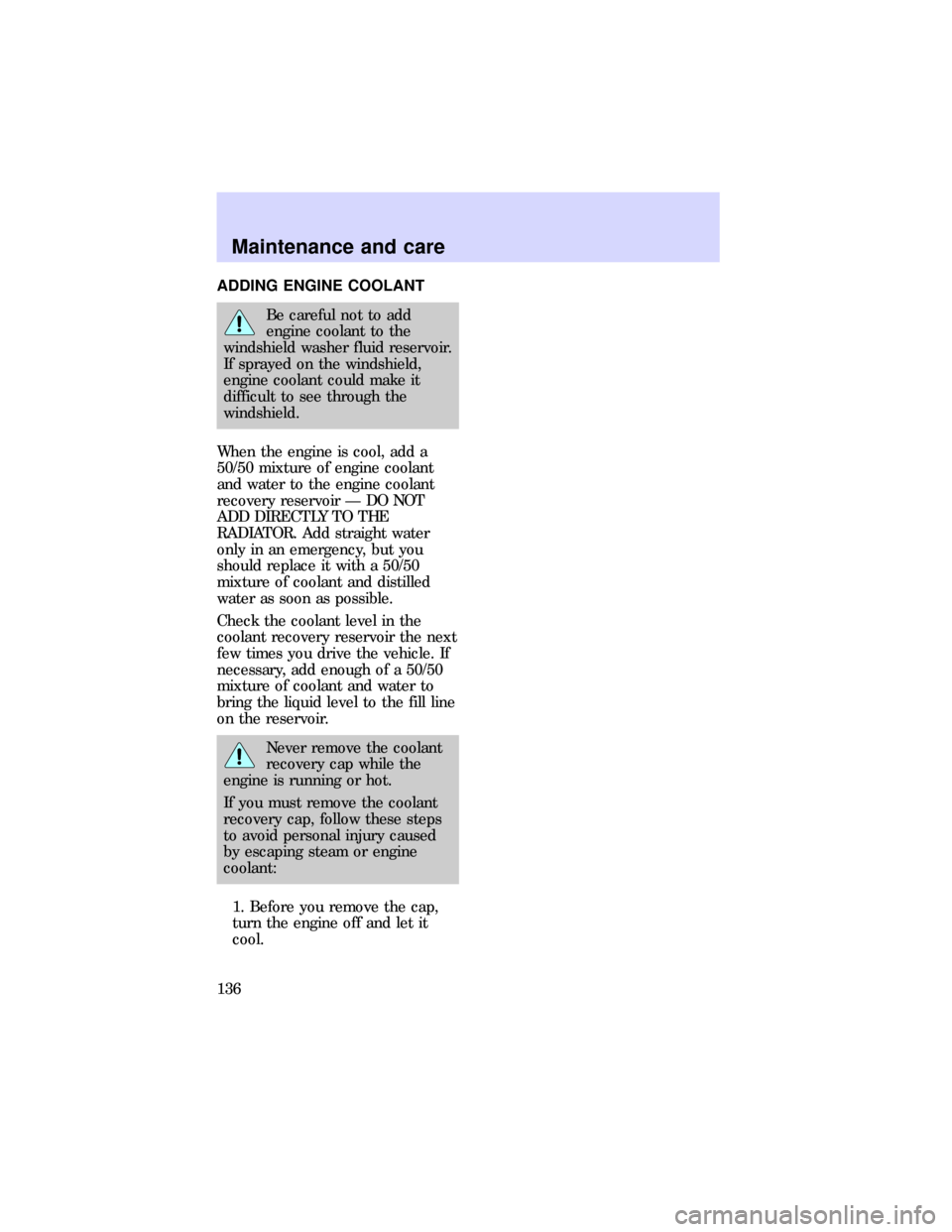Page 124 of 191

SERVICE RECOMMENDATIONS
Whenever possible, Ford has
designed parts that do not require
servicing. However when servicing
is required, Ford's goal is to make
servicing your vehicle as easy as
possible. To help you:
²We highlight do-it-yourself items
in the engine compartment for
easy location.
²Often, parts (such as the
headlamp bulbs) may be
replaced without tools.
²We provide you with aService
Guidethat makes tracking
routine service of your vehicle
easy.
If your vehicle requires
professional servicing, your
dealership can provide the
necessary parts and service. Check
theWarranty Information Guide
to find out what parts and services
are covered. Use only
recommended fuels, lubricants,
fluids, and service parts
conforming to Ford specifications.
Motorcraft parts are designed and
built to provide the best
performance in your vehicle.
Precautions for servicing your
vehicle
Be particularly careful when
inspecting or servicing your
vehicle. Here are some general
precautions for your safety:
Maintenance and care
124
Page 130 of 191
CHECKING AND ADDING
ENGINE OIL
Use SAE 5W-30 motor oil
CERTIFIED FOR GASOLINE
ENGINES by the American
Petroleum Institute. Look for the
certification Ð Ford specification
WSS-M2C153-F.
Additional engine oil additives, oil
treatments, or engine treatments
are never needed and could, under
certain conditions, lead to engine
damage which is not covered by
your Warranty.
Changing the engine oil and oil
filter
Change the engine oil and oil filter
per the following, whichever
occurs first.
5,000 MILES (8,000 KM) OR 6 MONTHS
NORMAL SCHEDULE
3,000 MILES (5,000 KM) OR 3 MONTHS
SEVERE DUTY SCHEDULE
EXTENSIVE IDLING
TRAILER TOWING
DRIVING IN SEVERE DUST
POLICE, TAXI, OR DELIVERY
Oil change intervals
Refer to theService Guide
booklet for additional information.
Checking the engine oil
Check the engine oil every time
you fuel your vehicle.
Maintenance and care
130
Page 131 of 191
To check the engine oil, follow
these steps:
1. Once the engine is warm, turn
the engine off. Make sure the
vehicle is parked on level ground.
2. Automatic transaxle:
²Engage the parking brake.
²Place the gearshift in P.
Manual transaxle:
²Engage the parking brake.
²Depress the clutch and place
the gearshift in first gear.
3. Open the hood. If you need
assistance, refer toOpening the
Hoodin this chapter. Protect
yourself from engine heat.
4. Remove the engine oil dipstick
and wipe it clean. Insert the
dipstick fully, then remove it again.
The oil level should be in the
range shown on the dipstick.
5. Carefully pull the dipstick out
again. If the oil level is below the
ADD arrow, add engine oil as
necessary. If the engine oil is
beyond the FULL arrow, engine
damage or high oil consumption
may occur and some oil must be
removed from the engine.
6. Put the dipstick back and
ensure that it is properly seated.
ADD FULL
Maintenance and care
131
Page 132 of 191
Adding engine
oil
1. Check the
engine oil. For
instructions,
refer to
Checking the
engine oilin this
chapter.
2. If the fluid
level is not
within the
normal range,
add engine oil by
removing the
engine oil filler cap and pouring in
oil.
3. Confirm that the oil level is full,
but be careful not to overfill the
engine.
Continuous contact with
USED motor oil has
caused cancer in laboratory rats.
Maintenance and care
132
Page 136 of 191

ADDING ENGINE COOLANT
Be careful not to add
engine coolant to the
windshield washer fluid reservoir.
If sprayed on the windshield,
engine coolant could make it
difficult to see through the
windshield.
When the engine is cool, add a
50/50 mixture of engine coolant
and water to the engine coolant
recovery reservoir Ð DO NOT
ADD DIRECTLY TO THE
RADIATOR. Add straight water
only in an emergency, but you
should replace it with a 50/50
mixture of coolant and distilled
water as soon as possible.
Check the coolant level in the
coolant recovery reservoir the next
few times you drive the vehicle. If
necessary, add enough of a 50/50
mixture of coolant and water to
bring the liquid level to the fill line
on the reservoir.
Never remove the coolant
recovery cap while the
engine is running or hot.
If you must remove the coolant
recovery cap, follow these steps
to avoid personal injury caused
by escaping steam or engine
coolant:
1. Before you remove the cap,
turn the engine off and let it
cool.
Maintenance and care
136
Page 138 of 191

produce coolant which meets Ford
specification ESE-M97B44-A, and
use of such coolant may harm
engine and cooling system
components.
Always dispose of used automotive
fluids in a responsible manner.
Follow your community's
regulations and standards for
recycling and disposing of
automotive fluids.
Coolant Refill Capacity
To find out how much fluid your
vehicle's cooling system can hold,
seeRefill capacities for fluidsin
the Index.
Have your dealer check the engine
cooling system for leaks if you
have to add more than a quart
(liter) of engine coolant per
month.
Severe Winter Climate
If you drive in extremely cold
climates (less than -34ÉF [-36ÉC]),
it may be necessary to increase the
coolant concentration above 50%.
Refer to the chart on the coolant
container to ensure the coolant
concentration in your vehicle is
such that the coolant will not
freeze at the temperature level in
which you drive during winter
months. Never increase the engine
coolant concentration above 60%.
Leave a 50/50 mixture of engine
coolant and water in your vehicle
year-round in non-extreme
climates.
Maintenance and care
138
Page 139 of 191
CHECKING AND ADDING
POWER STEERING FLUID
Check the power steering fluid at
least twice a year by completing
the following steps:
1. Start the engine.
2. When the engine coolant
temperature gauge reaches the
normal zone, turn off the engine.
3. Visually inspect the fluid level in
the power steering reservoir.
4. If necessary, add power steering
fluid until the fluid level reaches
MAX. Do not overfill the power
steering reservoir.
²As a maintenance precaution,
visually inspect the lines and
hoses of the power steering
system for leaks and damage.
²If new fluid is frequently
required, consult a qualified
service technician.
CHECKING AND ADDING
TRANSAXLE FLUID
Checking and adding automatic
transaxle fluid
Check the automatic transaxle
fluid according to the owner
maintenance checks in theService
Guide.
ON
II
ACC
I
LOCK
0
START
III
C
H
Maintenance and care
139
Page 144 of 191

If the electrolyte level becomes
low, refill the battery with distilled
water. If necessary, distilled water
may be substituted with tap water
that is not hard and does not have
a high mineral or alkali content. If
the battery needs water quite
often, have the charging system
checked for a possible malfunction.
Your vehicle is equipped with a
battery saver control feature
designed to prevent your battery
from accidental wear down due to
doors left ajar. For information on
the system and how it works, see
Interior overhead lampin this
chapter.
Because your vehicle's engine is
electronically controlled, some
control conditions are maintained
by power from the battery. When
the battery is disconnected or a
new battery is installed, the
computer must ªrelearnº its idle
conditions before your vehicle will
drive properly. To begin this
process:
1. Put the gearshift in P
(automatic transaxle) or N
(manual transaxle).
2. Turn off all accessories and start
the vehicle.
3. Let the engine idle for at least
one minute.
4. The relearning process will
automatically complete as you
drive the vehicle.
²If you do not allow the engine to
relearn its idle, the idle quality
Maintenance and care
144